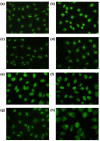Anti-nuclear autoantibodies in systemic sclerosis : News and perspectives
- PMID: 35382013
- PMCID: PMC8922602
- DOI: 10.1177/2397198318783930
Anti-nuclear autoantibodies in systemic sclerosis : News and perspectives
Abstract
Systemic sclerosis is a connective tissue disorder characterized by microvascular damage and excessive fibrosis of the skin and internal organs. One hallmark of the immunological abnormalities in systemic sclerosis is the presence of anti-nuclear antibodies, which are detected in more than 90% of patients with systemic sclerosis. Anti-centromere antibodies, anti-DNA topoisomerase I antibodies, and anti-RNA polymerase III antibodies are the predominant anti-nuclear antibodies found in systemic sclerosis patients. Other systemic sclerosis-related anti-nuclear antibodies include those targeted against U3 ribonucleoprotein, Th/To, U11/U12 ribonucleoprotein, and eukaryotic initiation factor 2B. Anti-U1 ribonucleoprotein, anti-Ku antibodies, anti-PM-Scl, and anti-RuvBL1/2 antibodies are associated with systemic sclerosis overlap syndrome. Anti-human upstream binding factor, anti-Ro52/TRIM21, anti-B23, and anti-centriole antibodies do not have specificity to systemic sclerosis, but are sometimes detected in sera from patients with systemic sclerosis. Identification of each systemic sclerosis-related antibody is useful to diagnose and predict organ involvement, since the particular type of systemic sclerosis-related antibodies is often predictive of clinical features, severity, and prognosis. The clinical phenotypes are largely influenced by ethnicity. Currently, an immunoprecipitation assay is necessary to detect most systemic sclerosis-related antibodies; therefore, the establishment of an easy, reliable, and simple screening system is warranted.
Keywords: Systemic sclerosis; anti-nuclear antibodies; autoantibodies; clinical features.
© The Author(s) 2018.
Conflict of interest statement
Declaration of conflicting interests: The author(s) declared no potential conflicts of interest with respect to the research, authorship, and/or publication of this article.
Figures

Similar articles
-
Antinuclear Antibodies in Systemic Sclerosis: an Update.Clin Rev Allergy Immunol. 2020 Feb;58(1):40-51. doi: 10.1007/s12016-018-8718-8. Clin Rev Allergy Immunol. 2020. PMID: 30607749 Review.
-
Systemic Sclerosis-Specific Antibodies: Novel and Classical Biomarkers.Clin Rev Allergy Immunol. 2023 Jun;64(3):412-430. doi: 10.1007/s12016-022-08946-w. Epub 2022 Jun 18. Clin Rev Allergy Immunol. 2023. PMID: 35716254 Free PMC article.
-
[Autoantibodies and their clinical characteristics in systemic sclerosis].Nihon Rinsho Meneki Gakkai Kaishi. 2013;36(3):139-47. doi: 10.2177/jsci.36.139. Nihon Rinsho Meneki Gakkai Kaishi. 2013. PMID: 23812071 Review. Japanese.
-
The clinical relevance of autoantibodies in scleroderma.Arthritis Res Ther. 2003;5(2):80-93. doi: 10.1186/ar628. Epub 2003 Feb 12. Arthritis Res Ther. 2003. PMID: 12718748 Free PMC article. Review.
-
Autoantibody profiles in systemic sclerosis: predictive value for clinical evaluation and prognosis.J Dermatol. 2010 Jan;37(1):42-53. doi: 10.1111/j.1346-8138.2009.00762.x. J Dermatol. 2010. PMID: 20175839 Review.
Cited by
-
Autoantibodies associated with systemic sclerosis in three autoimmune diseases imprinted by type I interferon gene dysregulation: a comparison across SLE, primary Sjögren's syndrome and systemic sclerosis.Lupus Sci Med. 2022 Dec;9(1):e000732. doi: 10.1136/lupus-2022-000732. Lupus Sci Med. 2022. PMID: 36581379 Free PMC article.
-
The Role of Endogenous Eicosapentaenoic Acid and Docosahexaenoic Acid-Derived Resolvins in Systemic Sclerosis.Front Immunol. 2020 Jun 19;11:1249. doi: 10.3389/fimmu.2020.01249. eCollection 2020. Front Immunol. 2020. PMID: 32636845 Free PMC article. Review.
-
Impact of autoantibody status on stratifying the risk of organ involvement and mortality in SSc: experience from a multicentre French cohort of 1605 patients.RMD Open. 2024 Nov 20;10(4):e004580. doi: 10.1136/rmdopen-2024-004580. RMD Open. 2024. PMID: 39572073 Free PMC article.
-
The Involvement of Smooth Muscle, Striated Muscle, and the Myocardium in Scleroderma: A Review.Int J Mol Sci. 2022 Oct 9;23(19):12011. doi: 10.3390/ijms231912011. Int J Mol Sci. 2022. PMID: 36233313 Free PMC article. Review.
-
Interstitial lung disease in anti-U1RNP systemic sclerosis patients: A European Scleroderma Trials and Research analysis.J Scleroderma Relat Disord. 2025 Mar 19:23971983251324827. doi: 10.1177/23971983251324827. Online ahead of print. J Scleroderma Relat Disord. 2025. PMID: 40124983 Free PMC article.
References
-
- Varga J, Trojanowska M, Kuwana M. Pathogenesis of systemic sclerosis: recent insights of molecular and cellular mechanisms and therapeutic opportunities. J Scleroderma Relat Disord 2017; 2: 137–152.
-
- LeRoy EC, Black C, Fleischmajer R, et al. . Scleroderma (systemic sclerosis): classification, subsets and pathogenesis. J Rheumatol 1988; 15: 202–205. - PubMed
-
- Allanore Y. Limited cutaneous systemic sclerosis: the unfairly neglected subset. J Scleroderma Relat Disord 2016; 1: 241–246.
-
- Tan EM. Antinuclear antibodies: diagnostic markers for autoimmune diseases and probes for cell biology. Adv Immunol 1989; 44: 93–151. - PubMed
-
- Fanning GC, Welsh KI, Bunn C, et al. . HLA associations in three mutually exclusive autoantibody subgroups in UK systemic sclerosis patients. Br J Rheumatol 1998; 37: 201–207. - PubMed
Publication types
LinkOut - more resources
Full Text Sources
Research Materials
Miscellaneous
